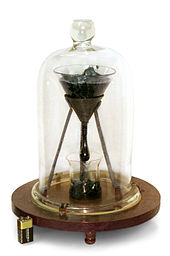PITCH DROP EXPERIMENT
The pitch drop experiment is a long-term experiment which measures the flow of a piece of pitch over many years. Pitch is the name for any of a number of highly viscous liquids which appear solid, most commonly bitumen. At room temperature, tar pitch flows at a very slow rate, taking several years to form a single drop.
The most famous version of the experiment was started in 1927 by Professor Thomas Parnell of the University of Queensland in Brisbane, Australia, to demonstrate to students that some substances that appear to be solid are in fact very-high-viscosity fluids. Parnell poured a heated sample of pitch into a sealed funnel and allowed it to settle for three years. In 1930, the seal at the neck of the funnel was cut, allowing the pitch to start flowing. Large droplets form and fall over the period of about a decade.
The eighth drop fell on 28 November 2000, allowing experimenters to calculate that the pitch has a viscosity approximately 230 billion (2.3×1011) times that of water.
The ninth drop is expected to fall in 2013!!
Timeline
| Date | Event | Duration (months) | Duration (years) |
|---|---|---|---|
| 1927 | Experiment set up | ||
| 1930 | The stem was cut | ||
| December 1938 | 1st drop fell | 96–107 | 8.0–8.9 |
| February 1947 | 2nd drop fell | 99 | 8.3 |
| April 1954 | 3rd drop fell | 86 | 7.2 |
| May 1962 | 4th drop fell | 97 | 8.1 |
| August 1970 | 5th drop fell | 99 | 8.3 |
| April 1979 | 6th drop fell | 104 | 8.7 |
| July 1988 | 7th drop fell | 111 | 9.3 |
| 28 November 2000 | 8th drop fell | 148 | 12.3 |

4 comentarios
Irene 6ºA -
Estibaliz -
Irene 6ºA -
I couldn´t imagine something more viscous!
(;
Anónimo -
I couldn´t imagine something more viscous!
(;